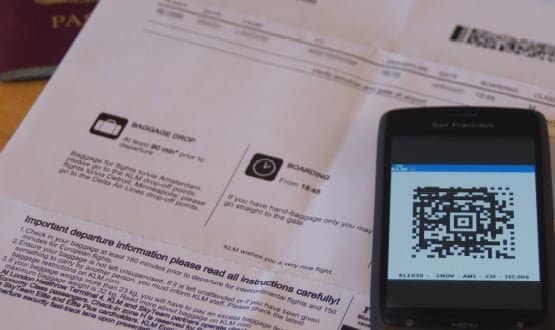I’ve just come back from a holiday in Italy – first to Sicily, then Venice. The holiday itself was fantastic – but the travel was a nightmare.
Save time! Check in on-line (or not)
I was really pressed for time in the week before we left. Never mind, I thought, I’ll save myself a job – I’ll check in online.
There were only two fields on the web page: ‘Booking reference’ and ‘Last name of passenger’. The latter was easy: I can usually remember my own name.
‘Booking reference’ was a different matter altogether. The paperwork provided by my tour operator incorporated a whole series of reference codes: the agent code; a reservation code; the airline reference; the flight number; and some others besides.
So I typed in what I thought was the correct reference number.
No find.
Were we actually not booked on that flight? I tried the other reference numbers one by one.
Nothing.
I rang the travel agent. They confirmed that I’d used the right reference number at my first attempt – but using it didn’t work for them either.
Sympathetically, they wondered if my many failed attempts to log-in had triggered a 24 hour lockout – which in view of the urgency was anything but helpful.
So the travel agent rang up the helpdesk. It took them four hours to get through. The original reference I’d used was indeed the right one – and for some reason it now worked.
Much the same thing happened (with a different airline) on the internal flight between Sicily and Venice – except that now I had to do it in Italian, and as I only speak menu, that proved tricky.
Even at the airport I couldn’t check in electronically – we didn’t appear to exist on the Alitalia database.
There was only one flight to Venice each week, and if we didn’t have seats, we’d lose much of the remainder of our holiday.
It later transpired that Alitalia had subcontracted our flight to a different carrier, even though it clearly said Alitalia on our documentation.
One way and another, something intended to make a process easier (checking in) turned out to have made it difficult, time-consuming and stressful.
Computers make things easier?
The problem with my first attempt at checking-in was very simple: too much detail diverted my attention.
The paperwork contained a plethora of reference numbers, each of which might or might not be the right one. Was it really necessary to include all of them?
Alternatively, why wasn’t the all-important real reference number printed in large bold type, clearly surrounded by a box, or printed in gold, or something?
Then there was the difficulty of knowing whether to use upper or lower case (or both); the problem inadvertently caused to a genuine but confused new user by the lock-out mechanism designed to stop inappropriate access; and an organisation that hadn’t quite remembered to mention that the carrier’s name had changed.
Human and non-human
Now I am not completely stupid when it comes to using computers. Yet (by definition) I’m a complete novice when using any website for the first time (as indeed is everyone else).
There’s a generic problem here which affects computer users the world over. Those designing retrieval systems can easily forget that identification mechanisms that work well for filing systems and computers translate badly into the world of human beings.
“I am not a number, I am a free man,” as the saying goes.
All too often, users are forced to use non-human, non-user-friendly identification methods such as long numbers or meaningless 12-character random text such as 6hGFzz15lBg.
Then, to compound the felony, the computer prints something on the screen such as ‘Enter code’ whose significance is either incomprehensible to anyone but the program’s system analyst, or else thoroughly ambiguous to the uninitiated.
These are exactly the problems that clinicians can experience when wrestling (sorry, interacting) with NHS IT.
When, as a patient, I log-in to my own GP's practice website – which in turn is directly connected to his primary care system – the login ID I have been allocated is a selection of totally unmemorable numbers and symbols.
I have to look it up every time I order a repeat prescription: and as far as I can see there’s no way to change it.
Obstacles like this should be actively designed out of NHS-approved systems. But even then, there’s the many and varied ways of confusing the computer with names.
Am I known to the computer as William Lockley (John is actually my middle name); or Dr William John Lockley; or John Lockley; or W John Lockley… It varies from system to system.
And my residence: house name, street number, or both? What if I use the wrong selection? (I got locked out of my bank’s computer once because it expected a house name but no number – and I gave it the number.)
The shock of the new
If things are bad for clinicians, what about patients? Do they risk being confused by technical terms, or by the subtle differences between the NHS Number, National Insurance Number, hospital number and laboratory reference number?
What if they are elderly, their memory or thinking processes are starting to fail, they have impaired vision or colour-blindness – or English as a second language?
Do they face a lockout after a sequence of failed attempts to log-in, as the computer tries to make sure it’s not being hacked? Will that help them in any way at all?
Proper user friendliness
Of course, this is all about proper user-friendliness. The cure is simple: always ensure that user-facing screens are so precisely worded and cleared of unnecessary clutter that it is impossible to get things wrong.
This doesn’t just mean clear instructions: it also means user-friendly error messages. Behind the scenes the software should be smart enough to work out that the user is trying to do the wrong thing and gently guide them in the right direction without making them feel either threatened or stupid.
“You seem to be trying to input a National Insurance Number, but we actually need your NHS Number, which has ten characters, like this: 123 456 7899”.
But even then we haven’t finished. Yet another layer of intelligent planning needs to happen, and that relates to the consistency of nomenclature.
Do the descriptive terms displayed on the computer screen match exactly the ones in the letter, the handout or the explanatory guide that the user has just received?
And the moral is…
At the heart of this are some massively important messages. We need to make sure that throughout the NHS the IT:
- Can be negotiated with ease by users who are unaccustomed to it – staff and patients alike
- Gives no possibility of getting two similar pieces of data muddled up, because: everything is clearly and consistently labelled; unnecessary information is removed; and help messages are both intelligently displayed and informative
- Remembers that computers are tools, not an end in themselves. Using the tool should always feel easier and more comfortable than not using it.


Dr John Lockley
Dr John Lockley is clinical lead for informatics at Bedfordshire Clinical Commissioning Group and a part-time GP.

